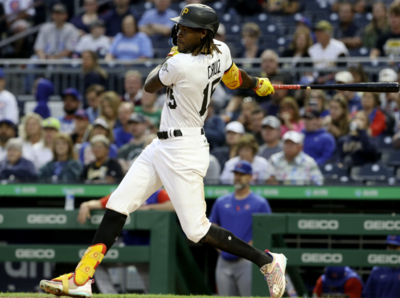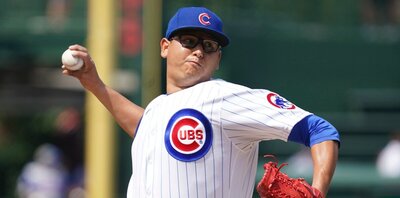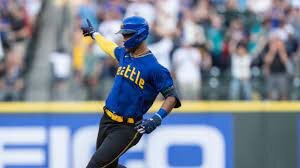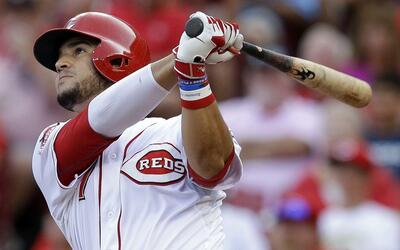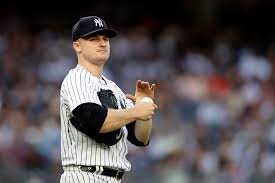Edwin Diaz
Diaz struck out two over a clean ninth inning to get his 16th save of the season against the Cubs on Friday. Although the Mets haven't won a whole lot of games, they have provided the sixth most opportunities in the league for saves with 33 -- 16 of which have been blown. Diaz has only blown three of those opportunities, but the 25-year-old has been one of the Mets' many problems this season and owns a disappointing 3.77 ERA for the year. Diaz's slider has been the main culprit for his struggles, and he doesn't seem to have the same command over the pitch that he did last season. Hitters are having an easier time identifying and hitting the pitch this year (part of the reason why Diaz's z-swing rate is way up to 77.1% after hovering at about 70% over each of the last three seasons), and Diaz is hitting the edge of the strike zone less frequently with the pitch, giving hitters clearer strikes. The good news is that Diaz appears to be righting the ship; he's had just one bad outing in his last six now, and his edge rate for his slider has improved dramatically in June after he apparently reigned the pitch in with a decreased spin rate. Diaz has also been burdened by an unsustainable .406 BABIP that should decrease as the season progresses. Expect Diaz to pitch well over the rest of the season, and it looks as though the Mets should provide him with plenty of opportunities despite their poor play. Buy low if you can.
Joe Panik
Panik went 1-4 and walked against the Diamondbacks on Friday. Panik was putting together what could be a breakout season (at leased based on his underlying metrics) earlier this year, but the 28-year-old has slowed down recently. Encouragingly, Panik appears to have added some power this year with a career best 38.4% hard hit rate, but it's been falling over the last few weeks. Also encouraging (and this time trending in the right direction) is Panik's decreasing ground ball rate. Panik's GB/FB ratio is down to 0.74, and he's posted a strong 27% line drive rate to go with it. If Panik can get his power to stick longer term, then he can be a valuable fantasy player. Panik already makes contact at an impressive 89.4% rate and rarely chases pitches, so adding power (which he's did last year and has been doing this year, per Fangraphs) to his already fairly high floor would make him a valuable fantasy asset.
Michael Wacha
Wacha picked up the win on Friday as he lasted six innings and allowed just one run. Wacha has struggled for the Cardinals this season, but an adjustment to his pitch mix or move to the bullpen might help boost his performance. Wacha's velocity is down again this season, and his fastball performance has declined as a result. Despite his fastball's decreasing effectiveness, Wacha has been relying on the pitch more than last year -- an especially surprising development considering that Wacha's changeup and curveball each appear to be strong pitches. Wacha's changeup boasts a whiffs/swing rate of over 39% (29% is the MLB average for changeups) and an average exit velocity of 87.1 MPH (below the major league average for all pitches) while his curveball has posted a whiffs/swing rate of 29% (roughly average for the pitch) and an impressive average exit velocity of just over 80 MPH. Even so, Wacha has increased his four-seamer usage while decreasing the usage of both his changeup and curveball, at least partially explaining his struggles this year. A repeat of last year's half-season of success was unlikely for a number of reasons, but if Wacha can optimize his pitch mix then he has a shot at fantasy relevance again.
Josh Bell
Bell went 0-3 and struck out twice against the Padres on Friday. Bell's performance fell off last season after he posted a largely unsubstantiated career-high 26 home runs in 2017, but the 26-year-old has become a legitimate power threat this year. Bell looks like a new hitter with his plate approach, increasing his z-swing rate more than ten points from his career average to an aggressive 80.9% while keeping his o-swing rate down at 30.6%, and his power numbers have improved as a result. Bell has been crushing the ball with a 94 MPH average exit velocity and 49.8% hard hit rate, driving his hot start to the year. Although Bell's performance has declined in recent weeks, his more recent trends are encouraging. Bell's hard hit rate dropped over his recent (relative) slump, but it's been rising over the past ten days and should pull his OPS with it. That being said, Bell's o-swing rate has been rising while his z-swing rate has been falling, so his declining plate discipline profile (unsurprising considering how improved it had been) may cap his rest of season ceiling. Still, Bell should continue playing well over the rest of the season unless he loses all of his plate discipline and power gains (he'll likely lose some, but losing all is highly unlikely), and expect him to keep performing well throughout the year.
Stephen Strasburg
Strasburg allowed three runs over six innings to get the win against the Braves on Friday. Strasburg had posted a mildly disappointing 3.75 ERA entering Friday's game, but there's a lot to like about how he's pitched so far this year. As his velocity continues to decline, Strasburg is effectively adjusting his pitch mix to favor soft contact and ground balls while maintaining a high strikeout rate. In order to make the transition, Strasburg has begun abandoning his fastball in favor of a deadly curveball (44.07% whiffs/swing) and a strong sinker, with both pitches generating ground balls at a greater than 50% rate. As a result, Strasburg has posted a 1.10 GB/FB ratio and 22% line drive rate, and his hard hit rate has dropped to 26.1%. Since Strasburg has developed his curveball into such a strong pitch while leaning on it more frequently (he now uses the pitch nearly 30% of the time) and maintained his impressive changeup, he's been able to improve his plate discipline and contact profiles while also inducing more soft contact and ground balls. Indeed, Strasburg has posted a 38.1% o-swing rate, 69.7% contact rate, and 14.2% swinging strike rate -- all numbers that suggest a strikeout rate even better than his current 29.6% mark. Expect Strasburg to see more strikeouts and fewer home runs over the rest of the season, and he should pitch like an All-Star over the rest of the year.










